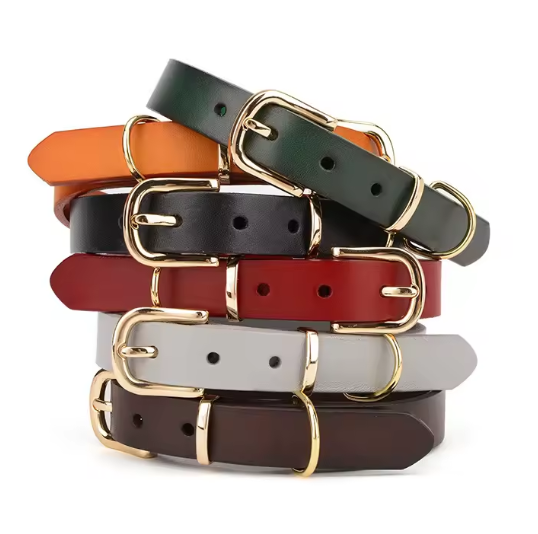Choosing the right collar for your dog is an important decision that can impact their comfort, safety, and behavior. With a plethora of options available, it can be overwhelming to determine which type of collar is best suited for your furry friend. This guide will help you navigate the various types of collars, their benefits, and how to choose the perfect one for your dog.
Types of Dog Collars
-
Flat Collars
- Description: Flat collars are the most common type of collar. They come in various materials such as nylon, leather, and fabric. They usually feature a buckle or quick-release snap for easy on and off.
- Benefits: Ideal for everyday use, holding ID tags, and easy to put on and remove.
- Best For: Dogs that are well-behaved on the leash and don’t have pulling issues.
-
Martingale Collars
- Description: Also known as limited-slip collars, martingale collars tighten when the dog pulls but stop before they become too tight. They are made of a combination of nylon and chain.
- Benefits: Prevents dogs from slipping out of the collar, offers more control without choking.
- Best For: Dogs with narrow heads, like Greyhounds, and those that tend to slip out of traditional collars.
-
Head Collars
- Description: Head collars fit around the dog’s muzzle and behind their ears. They work by controlling the dog’s head, similar to how a halter works for a horse.
- Benefits: Provides excellent control over dogs that pull, helps guide the dog’s head and body direction.
- Best For: Dogs that are strong pullers or need help focusing during training.
-
Harnesses
- Description: While not a collar, harnesses are a popular alternative. They fit around the dog’s chest and shoulders, distributing pressure across a larger area.
- Benefits: Reduces strain on the neck, provides better control, especially for dogs that pull or have respiratory issues.
- Best For: Dogs that pull on the leash, small breeds, and those with neck or respiratory issues.
-
Choke Chains
- Description: Choke chains are metal collars that tighten around the dog’s neck when they pull.
- Benefits: Provides strong control.
- Best For: Training purposes, but should be used with caution and under the guidance of a professional trainer.
-
Prong Collars
- Description: Prong collars have metal prongs that pinch the dog’s neck when they pull.
- Benefits: Effective for controlling strong pullers.
- Best For: Only for training purposes and under the guidance of an experienced trainer.
-
GPS Collars
- Description: GPS collars come equipped with tracking technology, allowing you to monitor your dog’s location.
- Benefits: Provides peace of mind for dog owners, especially those with dogs prone to wandering or escaping.
- Best For: Dogs that roam off-leash or have a history of escaping.
Factors to Consider When Choosing a Collar
-
Size and Fit
- The collar should fit snugly but not too tight. You should be able to fit two fingers comfortably between the collar and your dog’s neck. Measure your dog’s neck circumference and refer to sizing guides provided by the manufacturer.
-
Material
- Choose a collar made of durable, comfortable material. Nylon and leather are popular choices. Ensure the material is suitable for your dog’s skin and coat type to avoid irritation.
-
Purpose
- Consider the primary purpose of the collar. Is it for everyday use, training, or specific activities like hiking or swimming? Different collars serve different purposes, so choose accordingly.
-
Safety Features
- Look for collars with safety features such as breakaway clasps or reflective strips for visibility in low light conditions.
-
Training Needs
- If your dog has specific training needs, such as leash pulling or escaping, opt for collars designed to address those behaviors. Consult with a professional trainer if necessary.
How to Introduce a New Collar
Introducing a new collar to your dog requires patience and positive reinforcement:
-
Let Your Dog Explore the Collar
- Allow your dog to sniff and examine the collar before putting it on. This helps them become familiar with the new item.
-
Positive Association
- Use treats and praise to create a positive association with the collar. Reward your dog for calm behavior when the collar is nearby.
-
Gradual Introduction
- Start by putting the collar on for short periods, gradually increasing the time as your dog becomes more comfortable.
-
Monitor and Adjust
- Keep an eye on your dog to ensure they are comfortable and not trying to remove the collar. Adjust the fit as needed.
Special Considerations for Puppies
When selecting a collar for a puppy, keep the following in mind:
-
Adjustable Collars
- Puppies grow quickly, so choose an adjustable collar that can grow with them. This saves you from having to buy new collars frequently.
-
Lightweight and Comfortable
- Opt for lightweight and soft collars that won’t weigh down or irritate your puppy’s sensitive skin.
-
Training Collars
- Avoid using training collars like choke chains or prong collars on puppies. Stick to flat collars or harnesses until they are older and better trained.
Conclusion
Choosing the right collar for your dog is crucial for their comfort, safety, and overall well-being. With various options available, consider your dog’s specific needs, behaviour, and lifestyle when making your decision. Whether it’s a flat collar for everyday use, a martingale collar for added control, or a harness for pullers, the right collar can make a significant difference in your dog’s life. Always prioritize fit, material, and purpose to ensure your furry friend is happy and safe. By introducing the collar gradually and using positive reinforcement, you can make the experience pleasant and stress-free for your dog.

